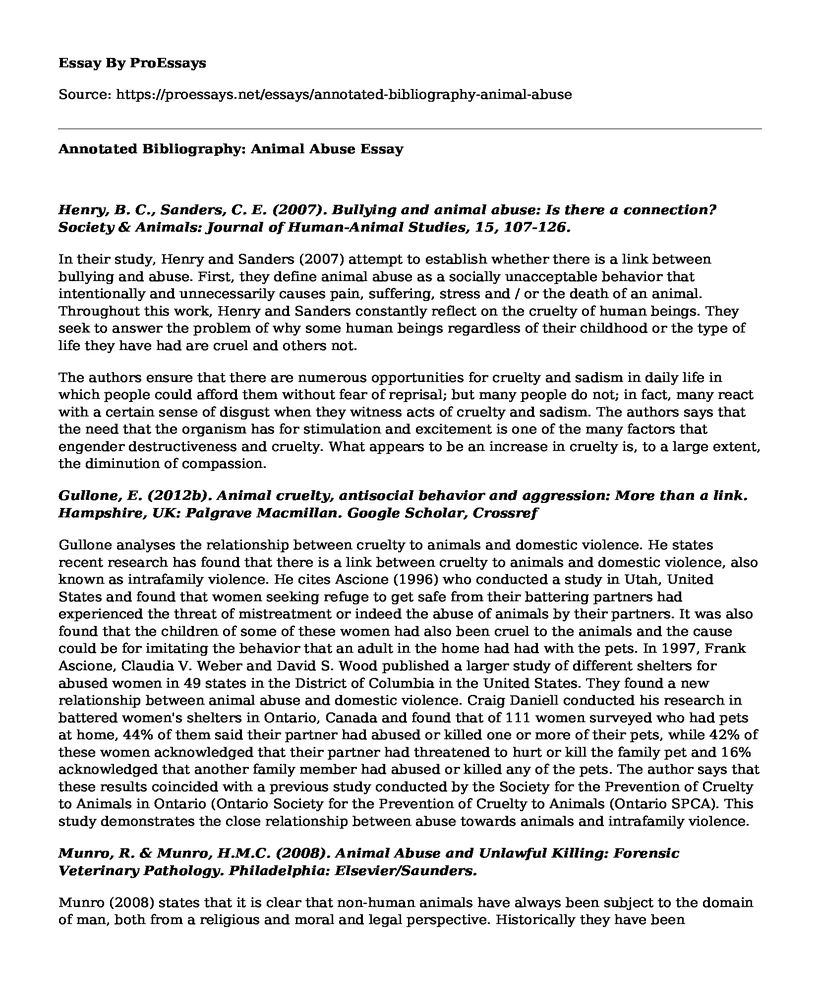Henry, B. C., Sanders, C. E. (2007). Bullying and animal abuse: Is there a connection? Society & Animals: Journal of Human-Animal Studies, 15, 107-126.
In their study, Henry and Sanders (2007) attempt to establish whether there is a link between bullying and abuse. First, they define animal abuse as a socially unacceptable behavior that intentionally and unnecessarily causes pain, suffering, stress and / or the death of an animal. Throughout this work, Henry and Sanders constantly reflect on the cruelty of human beings. They seek to answer the problem of why some human beings regardless of their childhood or the type of life they have had are cruel and others not.
The authors ensure that there are numerous opportunities for cruelty and sadism in daily life in which people could afford them without fear of reprisal; but many people do not; in fact, many react with a certain sense of disgust when they witness acts of cruelty and sadism. The authors says that the need that the organism has for stimulation and excitement is one of the many factors that engender destructiveness and cruelty. What appears to be an increase in cruelty is, to a large extent, the diminution of compassion.
Gullone, E. (2012b). Animal cruelty, antisocial behavior and aggression: More than a link. Hampshire, UK: Palgrave Macmillan. Google Scholar, Crossref
Gullone analyses the relationship between cruelty to animals and domestic violence. He states recent research has found that there is a link between cruelty to animals and domestic violence, also known as intrafamily violence. He cites Ascione (1996) who conducted a study in Utah, United States and found that women seeking refuge to get safe from their battering partners had experienced the threat of mistreatment or indeed the abuse of animals by their partners. It was also found that the children of some of these women had also been cruel to the animals and the cause could be for imitating the behavior that an adult in the home had had with the pets. In 1997, Frank Ascione, Claudia V. Weber and David S. Wood published a larger study of different shelters for abused women in 49 states in the District of Columbia in the United States. They found a new relationship between animal abuse and domestic violence. Craig Daniell conducted his research in battered women's shelters in Ontario, Canada and found that of 111 women surveyed who had pets at home, 44% of them said their partner had abused or killed one or more of their pets, while 42% of these women acknowledged that their partner had threatened to hurt or kill the family pet and 16% acknowledged that another family member had abused or killed any of the pets. The author says that these results coincided with a previous study conducted by the Society for the Prevention of Cruelty to Animals in Ontario (Ontario Society for the Prevention of Cruelty to Animals (Ontario SPCA). This study demonstrates the close relationship between abuse towards animals and intrafamily violence.
Munro, R. & Munro, H.M.C. (2008). Animal Abuse and Unlawful Killing: Forensic Veterinary Pathology. Philadelphia: Elsevier/Saunders.
Munro (2008) states that it is clear that non-human animals have always been subject to the domain of man, both from a religious and moral and legal perspective. Historically they have been considered ready means in benefit of an end, being the man the only end in itself, nevertheless, this idea of the dominion of the man, also has been questioned, because it appears like an absolute dominion, with the power to commit abuses without any limitation against the weakest beings of creation. Munro proposes an ethics, which starting from man, also addresses the rest of the animals, attacking what he calls "speciesism", which consists in the belief of the superiority of one species over the rest. Through his theory he seeks end the "tyranny of humans over non-humans", postulating that animals are sentient and independent beings and not mere objects at the service of man's interests. This reasoning is not wrong, as it is evident that there are substantial differences between human beings and nonhumans, which should give rise to certain differences in the rights that are recognized to each, however, this fact does not prevent extending the principle of equality to animals. The principle of equality, as indicated, does not require equal or identical treatment, but a same consideration, equality in consideration for beings that present differences, leads to different treatment and therefore to different rights. The author concludes by stating that the principle of equality is clearly applicable to all individuals, human or not, at least as regards the consideration of suffering. Pain and suffering are bad in themselves and should be avoided or minimized, regardless of race, sex or the species of being that suffers. Pain is measured by its intensity and duration, and pains of the same intensity and duration are as harmful to humans as to animals.
Cite this page
Annotated Bibliography: Animal Abuse. (2022, Apr 16). Retrieved from https://proessays.net/essays/annotated-bibliography-animal-abuse
If you are the original author of this essay and no longer wish to have it published on the ProEssays website, please click below to request its removal:
- Paper Example on Cocaine Commodity Value Chain
- Personal Liberty, Freedom of Expression and Propaganda Paper Exaample
- Essay Sample on the War on Islamic Law: The Impact of Terrorism on Religious Relations
- Economic Development of Rwanda Paper Example
- Chinese Immigrants Create Refuge in Chinatown: New York's Ethnic-Based Community - Essay Sample
- Asian Americans: Representation in U.S. Media and Its Impact - Essay Sample
- Paper Example on COVID-19: Impact on Global Immigration and Economy







